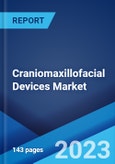The global craniomaxillofacial (CMF) devices market size reached US$ 1.9 Billion in 2022. Looking forward, the publisher expects the market to reach US$ 3.0 Billion by 2028, exhibiting a growth rate (CAGR) of 7.6% during 2023-2028.
Craniomaxillofacial (CMF) devices are medical equipment used during orthopedic surgeries to correct congenital conditions of the head and face. They include cranial flap fixtures, mid-face implant systems, screws, bolts, and bone-graft substitutes. They are manufactured using various materials, including steel and titanium, bioabsorbable polymers, and ceramics. They are extensively used to treat cranial and facial bone injuries, thoracic fixation, and temporomandibular joint replacement. Besides this, they are employed in neurosurgery, plastic surgery, orthognathic and dental surgeries. As a result, the demand for CMF devices is significantly surging across the globe.
Craniomaxillofacial (CMF) devices are medical equipment used during orthopedic surgeries to correct congenital conditions of the head and face. They include cranial flap fixtures, mid-face implant systems, screws, bolts, and bone-graft substitutes. They are manufactured using various materials, including steel and titanium, bioabsorbable polymers, and ceramics. They are extensively used to treat cranial and facial bone injuries, thoracic fixation, and temporomandibular joint replacement. Besides this, they are employed in neurosurgery, plastic surgery, orthognathic and dental surgeries. As a result, the demand for CMF devices is significantly surging across the globe.
Craniomaxillofacial (CMF) Devices Market Trends:
Increasing road accidents and cranial fractures, along with the rising demand for minimally invasive (MI) facial reconstruction surgeries, represent one of the key factors positively influencing the market. In addition, the increasing awareness among individuals about the benefits of CMF devices, such as faster recovery, smaller incisions, and minimal complications post-surgery, is strengthening the market growth. Apart from this, the growing adoption of deep brain stimulation procedures is catalyzing the demand for CMF devices across the globe. CMF implants are used in these procedures to cover the skull after placing electrodes. Furthermore, the introduction of three-dimensional (3D) printed implants and titanium cranial fixation systems with a lower risk of infection is creating a positive market outlook. Moreover, increasing consumer expenditure capacity and significant development in the healthcare infrastructure are the other factors driving the market.Key Market Segmentation:
The publisher provides an analysis of the key trends in each segment of the global craniomaxillofacial (CMF) devices market report, along with forecasts at the global, regional, and country levels from 2023-2028. The report has categorized the market based on product type, material type, application, fixator type, and end-user.Breakup by Product Type:
- Cranial Flap Fixation Systems
- Distraction Systems
- Temporomandibular Joint Replacement Systems
- Thoracic Fixation Systems
- MF Plate and Screw Fixation Systems
- Bone-Graft Substitutes
- Others
Breakup by Material Type:
- Metals and Alloys
- Bioabsorbable Materials
- Ceramics
- Others
Breakup by Application:
- Neurosurgery & ENT
- Orthognathic and Dental Surgery
- Plastic Surgery
- Others
Breakup by Fixator Type:
- Based on Application Site
- Internal Fixators
- External Fixators
- Based on Resorbability
- Resorbable Fixators
- Non-resorbable Fixators
Breakup by End-User:
- Hospitals and Clinics
- Ambulatory Surgical Centres
- Others
Breakup by Region:
- North America
- United States
- Canada
- Asia Pacific
- China
- Japan
- India
- South Korea
- Australia
- Indonesia
- Others
- Europe
- Germany
- France
- United Kingdom
- Italy
- Spain
- Russia
- Others
- Latin America
- Brazil
- Mexico
- Others
- Middle East and Africa
Competitive Landscape:
The competitive landscape of the industry has also been examined with some of the key players being Integra Lifesciences Corporation, Johnson & Johnson Medical Devices Companies (JJMDC), KLS Martin, Medartis AG, Medtronic Inc., OsteoMed, Stryker Corporation, TMJ Concepts, Zimmer Biomet Inc., etc.Key Questions Answered in This Report:
- How has the global craniomaxillofacial devices market performed so far and how will it perform in the coming years?
- What are the key regional markets?
- What has been the impact of COVID-19 on the global craniomaxillofacial devices market?
- What is the breakup of the market based on the product type?
- What is the breakup of the market based on the material type?
- What is the breakup of the market based on the application?
- What is the breakup of the market based on the fixator type?
- What is the breakup of the market based on the end-user?
- What are the various stages in the value chain of the industry?
- What are the key driving factors and challenges in the industry?
- What is the structure of the global craniomaxillofacial devices market and who are the key players?
- What is the degree of competition in the industry?
Table of Contents
1 Preface3 Executive Summary13 Value Chain Analysis15 Price Indicators
2 Scope and Methodology
4 Introduction
5 Global Craniomaxillofacial Devices Market
6 Market Breakup by Product Type
7 Market Breakup by Material Type
8 Market Breakup by Application
9 Market Breakup by Fixator Type
10 Market Breakup by End-User
11 Market Breakup by Region
12 SWOT Analysis
14 Porters Five Forces Analysis
16 Competitive Landscape
Companies Mentioned
- Integra Lifesciences Corporation
- Johnson & Johnson Medical Devices Companies (JJMDC)
- KLS Martin
- Medartis AG
- Medtronic Inc.
- OsteoMed
- Stryker Corporation
- TMJ Concepts
- Zimmer Biomet Inc
Methodology

LOADING...
Table Information
| Report Attribute | Details |
|---|---|
| No. of Pages | 143 |
| Published | September 2023 |
| Forecast Period | 2022 - 2028 |
| Estimated Market Value ( USD | $ 1.9 Billion |
| Forecasted Market Value ( USD | $ 3 Billion |
| Compound Annual Growth Rate | 7.9% |
| Regions Covered | Global |
| No. of Companies Mentioned | 9 |









